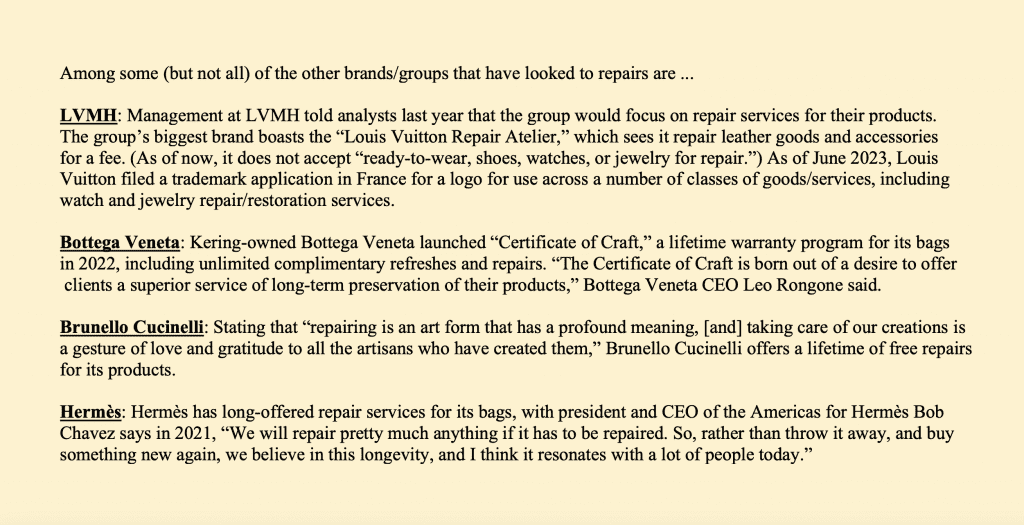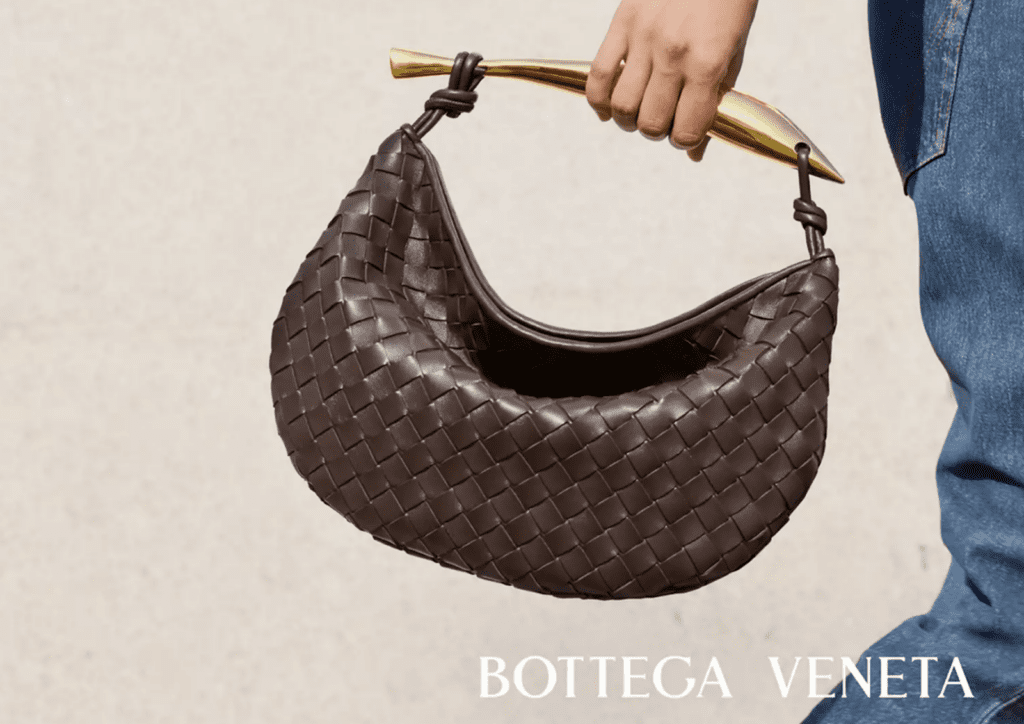A growing number of luxury goods brands – and even some fashion companies – are adding repairs to the offerings under their umbrellas, either by way of in-house programs or partnerships with third party refurbishment companies. One need not look further than Chanel, for example, which previouslyrolled out a new 5-year guarantee for all CHANEL handbags and CHANEL wallets on chain” acquired from its boutiques beginning in April 2021 (the warranty carries with it parts-replacement and product repair benefits), as well as its “CHANEL Restoring Care,” which enables consumers to have Chanel’s craftsmen “repair and rejuvenate” certain Chanel products. All the while, the company has shed some additional light on its ambitions in this space by way the trademark applications for registration that it has filed in recent years for both time-tested and newly-created trademarks for use in connection with the “cleaning and repair of fashion and fashion accessories.”
Since Chanel first caught our attention with its repair-focused trademark filings back in 2020, it has lodged an array of additional applications – in late 2022 and into 2023 with trademark offices in Japan, Indonesia, Brazil, Denmark, etc. – for the “CHANEL” word mark for use in connection with restoration-centric services, which could be seen as a sign that the luxury stalwart is planning to expand the reach of its “refurbishment” services to consumers in more markets. (Note: The relevant international trademark class here is 37.)

The Reasoning Behind Repairs
Chances are, no shortage of brands – both in luxury and the fast fashion realms – are leaning into repair initiatives in order to engender goodwill among consumers, who are increasingly conscious of the environmental, social, and governance (“ESG”) elements of the fashion business, and also to boost the value of their brands. Studies have repeatedly shown that ESG activities can help create brand value for multi-national corporations. According to one McKinsey report, “The overwhelming weight of accumulated research finds that … a strong ESG proposition correlates with higher equity returns,” while also enabling companies to benefit by “tapping new markets and expanding into existing ones.”
More nuanced that merely a brand-building play, as we proposed before, the introduction of certain warranty programs and repair endeavors may also serve as a way to brands to supplement (or justify?) their enduring – and at times, eye-watering – price increases; by advertising these services, especially complimentary ones, luxury brands are essentially providing consumers with additional value, potentially with the aim of softening the blow of soaring price tags.
Still yet – and maybe most importantly, there is the undeniable element of regulation, as lawmakers and regulators around the world pay greater attention to sustainability/climate change and enact rules to address concerns in these arenas. Early last month, for instance, the European Commission proposed rules that would amend the existing Waste Framework Directive to introduce a mandatory and harmonized Extended Producer Responsibility (“EPR”) scheme for textiles in all EU Member States, with lawmakers “now drafting more than a dozen new laws that will require brands to make their production processes greener and take greater responsibility for waste associated with their products,” according to the WSJ. Not limited to the EU, textile-specific ERP legislation has been introduced stateside, primarily in California.
With an emphasis on end-of-life responsibility rising among brands, part of the theory behind emerging repair and refurbishments efforts is likely that if companies can keep products in circulation longer (either by way of continued use by the original purchaser or by subsequent owner thanks to the resale market), they do not have to worry about – or pay for – their disposal. (This can be a particularly thorny issue for apparel companies due to the difficulty in recycling many types of textiles, and for luxury brands that carefully seek to keep their trademark-bearing goods out of unapproved distribution channels.)
This is where a recent French scheme comes in: The French government announced last month that it will partner with third parties, including “sewing workshops and shoemakers,” to offer cash to consumers who seek out repairs to incentivize consumers to repair their existing garments and shoes instead of buying new ones. Customers will be able to claim between €6 ($7) to €25 ($28) for clothing and footwear repairs, depending on the complexity of the repair. The rebate scheme, which was introduced by Secretary of State for Ecology Berangere Couillard, will be implemented in October 2023 with the help of eco-organization Refashion and will consist of a fund into which the government will pay €154 million over 5 years.
In addition to marking the latest environmental, social, and governance-focused effort by French authorities, the impending repair scheme is particularly interesting in light of the role that brands, themselves, might play. “The goal is to support those who do the repairs,” Couillard said, referring to sewing workshops but also brands that offer repair services. This certainly leaves the door open for fashion/luxury companies that have in-house repair initiatives in place.
What to Watch For: Against this background, it will be striking to see what role brands end up playing, and whether mounting regulatory activity (paired with companies’ desires to not only keep raising price tags but to cater to new generations of climate-conscious consumers) prompts not only more refurbishments efforts – but beyond that, more resale efforts among notoriously-hesitant luxury players.














